DEIB: The Ultimate Workplace Guide to Diversity, Equity, Inclusion and Belonging
Diversity, equity, inclusion, and belonging (DEIB) aren’t just HR buzzwords; they can help your business and employees thrive. The goal is to create a work environment where everyone feels included, heard, and offered the same opportunities.
However, DEIB practices shouldn’t just happen once your top talent is already in the office. These should be implemented long before that; when searching for job seekers begins.
Hiring diverse talent contributes to increased levels of employee engagement and enjoyment. Plus, removing inequities can give people the confidence to speak up and lead your organization to innovate more rapidly.
Here’s how and why you should introduce DEIB practices to your workplace environment. Plus, how you measure its impact, adjust, and improve.
What Does DEIB Stand For?
![DEIB Meaning: The Busy Leader’s Guide [Infographic]](https://mostlovedworkplace.com/wp-content/uploads/2022/11/DEIB-The-Busy-Leaders-Guide.png)
The DEIB acronym stands for:
- Diversity
- Equity
- Inclusion
- Belonging
It’s going to be an initiative that we see talked about more and more by companies that are striving for a diverse workforce with a strong sense of belonging. In fact, the “B” was only added recently to the DEI values, but it represents the outcome of achieving the former three.
|
Diversity |
Workforce hiring that doesn’t discriminate based on age, gender identity, ethnicity, sexual orientation, physical ability, religion, etc. |
|
Equity |
Building a fair and balanced workplace for all employees, so there are no underrepresented groups or unconscious bias. |
|
Inclusion |
Creating an environment where everyone feels welcome and open communication is encouraged. |
|
Belonging |
The sense of community and acceptance employees feel when the above strategies (DEI) are tackled. |
It’s one thing to refer to DEIB within your hiring process. It’s another to commit to implementing these values by making real changes. However, a leadership team willing to commit to building a more diverse, inclusive workforce will likely see a more productive, happier one.
Why Does Your Company Need a DEIB Strategy?
Employees want to feel like they’re part of a positive, functional community (one of the main indicators of a Most Loved Workplace), and 94% of those we recently surveyed reported they’re 2-4x more likely to produce more for their organization if they love their workplace.
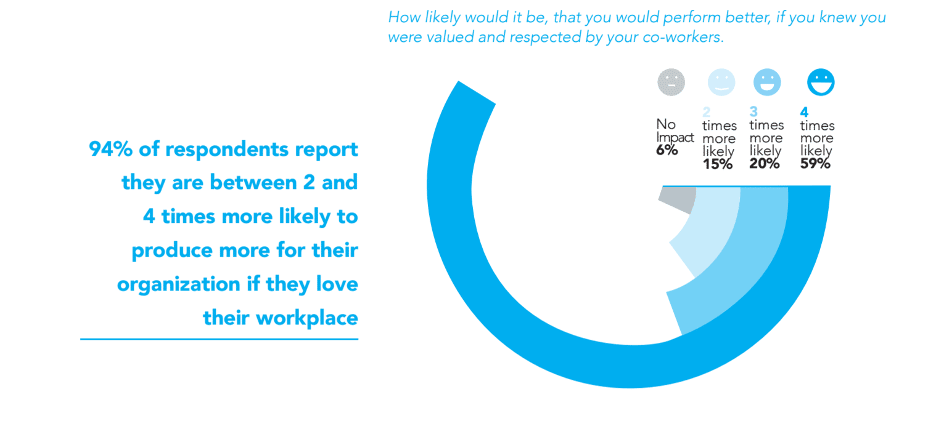
So, implementing these DEIB efforts will lead to a more engaged, effective workforce. There are numerous other benefits (including those that will be unique to your company), but some of the most popular are:
- A wider range of expertise means more varied creative ideas
- Your talent acquisition pool greatly expands due to equal access
- Employees feel more connected to your cause and values
- Job satisfaction and retention increases
- People feel they can bring their authentic selves into an inclusive environment
Though you may not believe it, compensation and extra work benefits are the least likely ways to create an enjoyable employee experience. People prefer to work for organizations that respect and share their values.
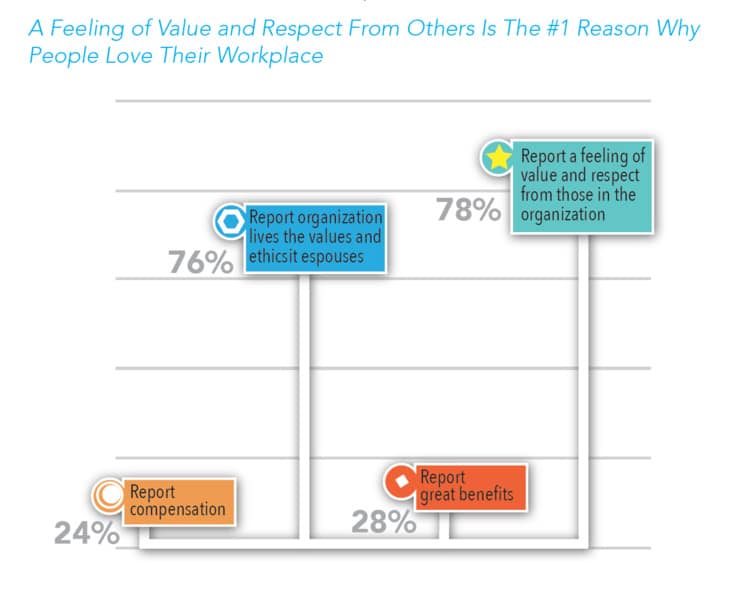
Creating this kind of inclusive workplace and culture of belonging starts with working out the DEIB practices you aren’t yet implementing. Then creating a plan and organizing DEIB training for those delivering it.
Types of DEIB Initiatives You Can Implement
The actions and strategies that make up successful DEIB initiatives have to be deliberate. First, you need to understand the current employee experience and work environment you’re offering. Is it a workplace of integrity or division? This involves asking a wide range of people for feedback and really listening to the responses.
Then you have to be clear on your intentions and engage in a lot of learning to create a plan to address these. After that, it’s time to execute each of the initiatives you’ve planned and be willing to adapt as you progress.
The types of initiatives your organization undertakes will be unique to your business and current set-up, but here are some ideas to get you started:
- Introduce diverse holidays and occasions
- Promote diversity in your application and hiring process
- Carefully-designed unconscious bias training
- Create Employee Resource Groups (ERGs)
- Frequently assess all levels to ensure inclusion
- Give recognition for achievements
- Align employees’ personal goals with company vision
- Make all elements of company life accessible
1. Introduce Diverse Holidays and Occasions
Shutting down the company for Christmas may be a tradition you’ve always observed, but what about those employees with national origins who don’t celebrate the holiday? Depending on religious beliefs or demographic, their important occasions may fall at different times of the year.
Introducing a flexible time-off policy could allow employees from all backgrounds to enjoy specific events and celebrations. There will also be far more opportunities to do something extra for employees, such as inviting external speakers for Black History Month, organizing discussion groups during Pride and generally showing support for other cultures and orientations.
2. Promote Diversity in Your Application and Hiring Process
Studies show that many African American and Asian job applicants have “whitened” their resumes to increase their chances of progressing to the interview stage. This can involve changing “foreign-sounding” names (e.g., Lei to Luke) or adding “Americanized” interests like hiking or kayaking.
By promoting diversity in your application and hiring process (such as making candidate names anonymous), you’re removing that fear and allowing diverse employees to apply as their authentic selves. You can also use automated tools to pinpoint and remove discriminatory language from job posts and performance feedback.
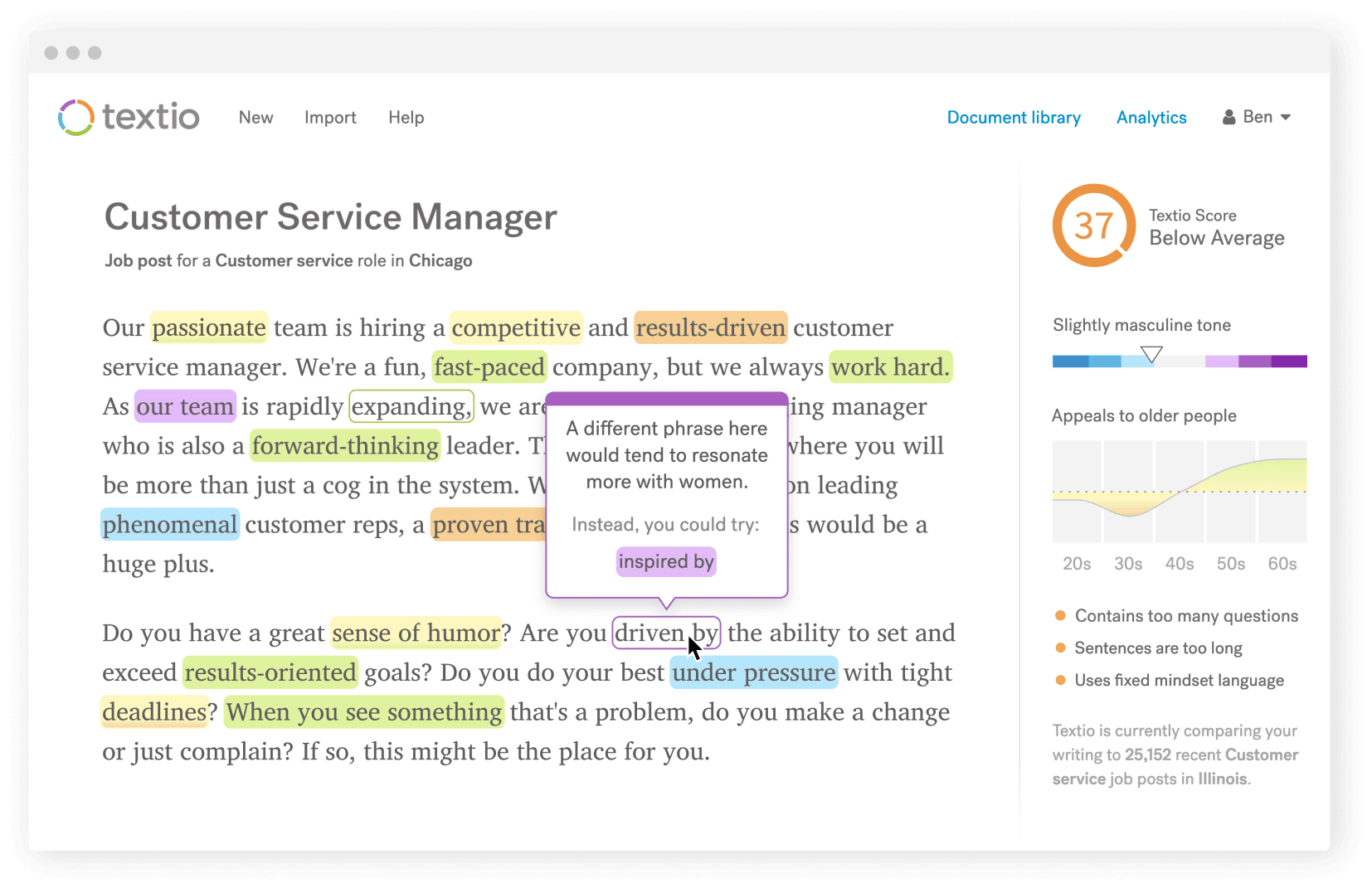
Just how diverse you make your application and hiring processes is up to you, but why not start with something simple, like encouraging your current diverse workforce to refer people they know to the job application? You could even offer a finder’s fee as a bonus for successful applicants that make it through their trial period.
3. Carefully-Designed Unconscious Bias Training
Unconscious biases are the varying levels of deep-rooted prejudices we all have from living in profoundly unequal societies. However, they are some of the most difficult to pinpoint because their nature means we don’t realize we have them. Offering training for your workforce to combat this can’t just be a tick-box exercise which is likely to have little to no impact.
You’re not there to “fix” everyone’s unconscious bias, that’s nearly impossible, but your training should draw awareness to it. So, any sessions you deliver should be designed thoughtfully to give your team the tools to consider their own and where they stem from. Change and shared values start at the top, so it’s important that senior leaders undertake this training too.
4. Create Employee Resource Groups (ERGs)
ERGs (employee resource groups) are employee-led and comprised of volunteers who share the same characteristics, such as race, religious beliefs, or circumstance. They originated in the 1960s at Xerox, which had a progressive recruitment program for the time, but some workers still faced discrimination once hired. ERGs allowed them to discuss their experiences with race-based tension in the workplace in a safe environment.
Creating an equitable workplace means striving to offer equal opportunities for all, and these groups are becoming increasingly relevant as the workforce diversifies. They provide a place for workers to discuss:
- Personal and career development
- Physical aspects of the workplace (e.g., how to improve accessibility)
- Working conditions and psychological safety
- Topics or issues anonymously brought up
Here’s an example of the types of ERGs at Barclays bank:
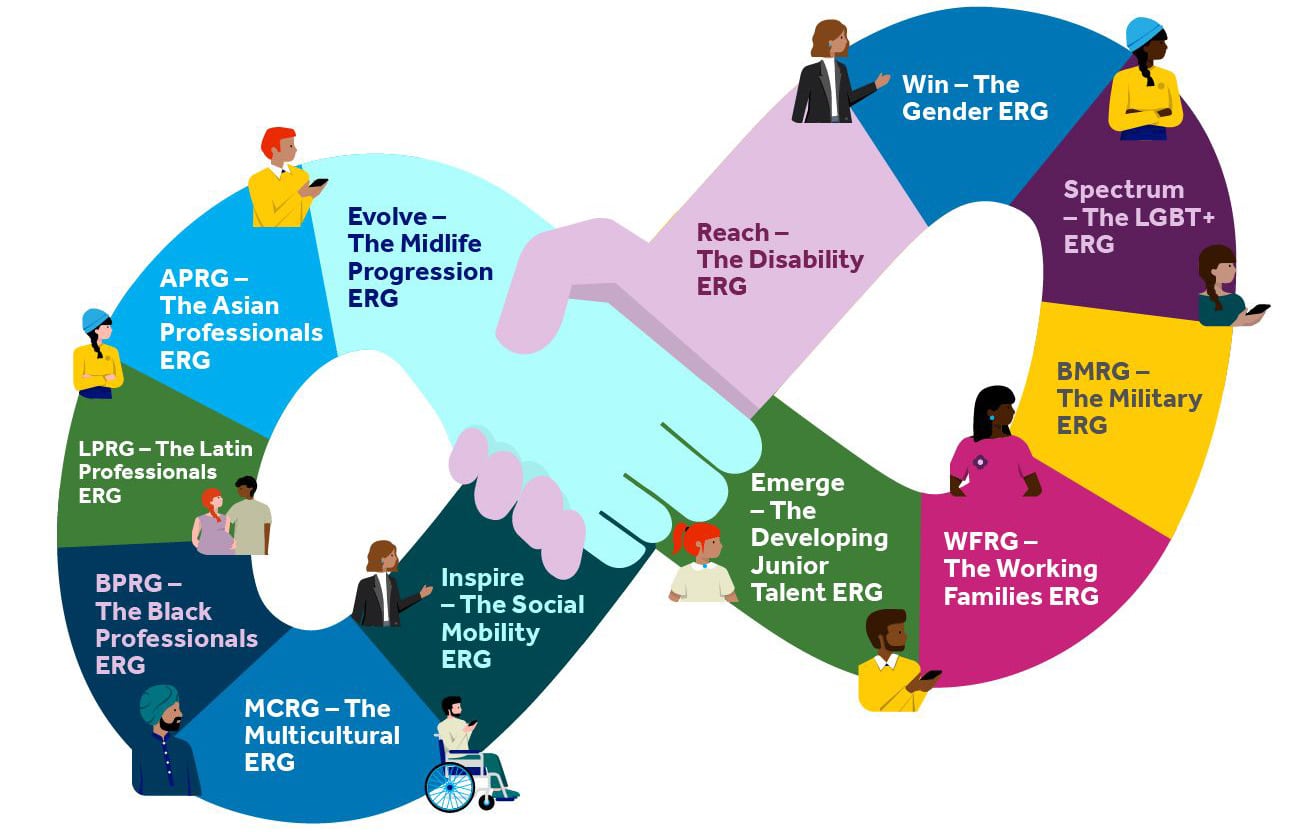
Any committees involved in decision-making could have observers from ERGs sit in on meetings and help flag any influenced by biases. Consider how mentorship programs could also help underrepresented groups and how you could make that a reality.
5. Frequently Assess All Levels To Ensure Inclusion
Diversity doesn’t guarantee inclusion, and companies should have zero tolerance for behavior that excludes anyone in the workplace, such as bullying or harassment. One of the hardest to pinpoint (but most important to identify and track) are microaggressions. Training should be provided here to help those responsible become more conscious and sensitive to their communication styles.
Black frontline employees report feeling less included in the workplace than any other racial group. These types of disparities within your business should be unearthed and investigated to find out how you can improve your own levels of inclusion.
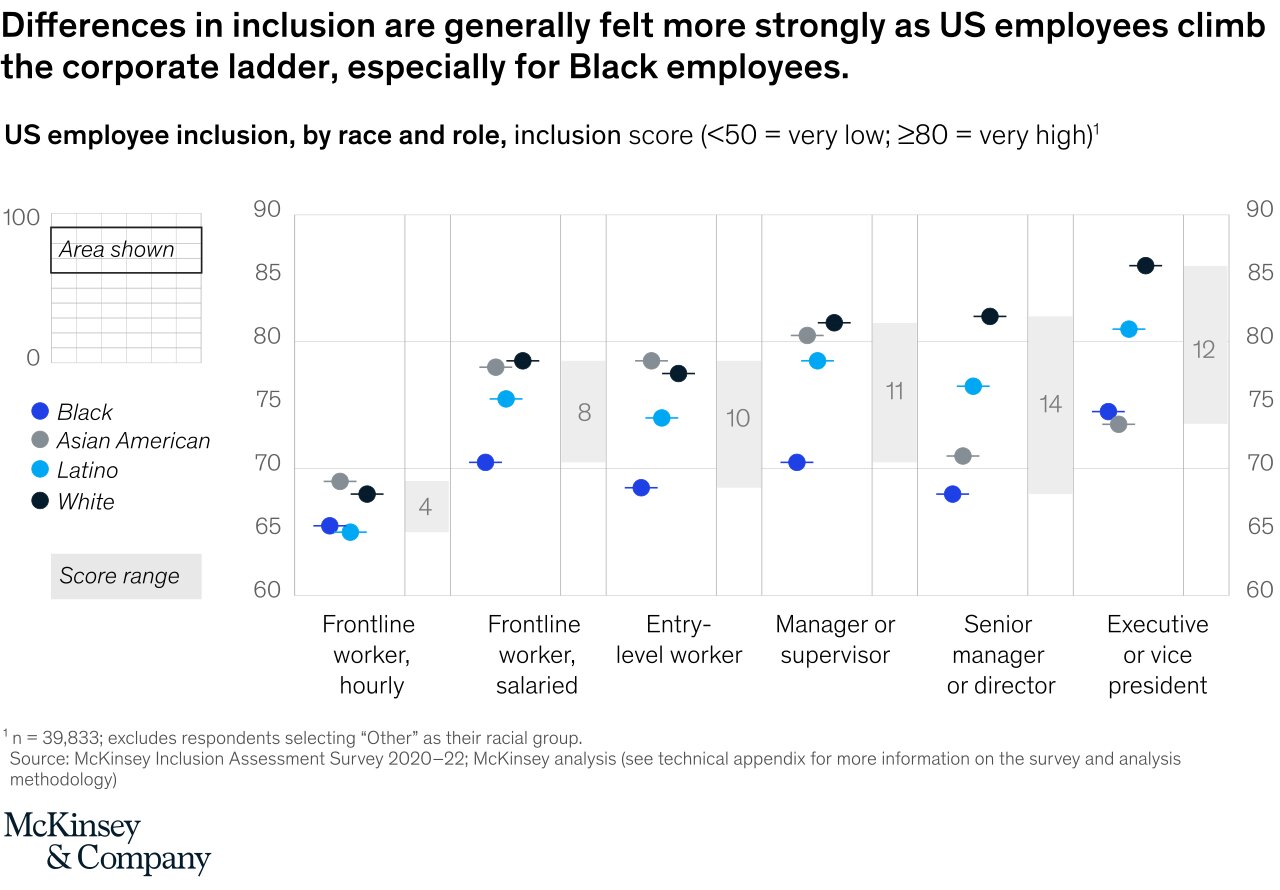
Welcoming and open behavior from everyone should be the norm, and there should be frequent assessments for all levels to ensure they’re meeting the required standard.
6. Give Recognition for Achievements
Most organizations are quick to criticize workers for mistakes and lack of productivity. Far less give enough recognition for a job well done, despite it being a much more pleasant experience for all. Recognizing specific employees increases job satisfaction and stops them from feeling like just a number.
This can be as simple as praising them for smaller achievements or expressing gratitude. However, it can also be a larger event, like taking them out to lunch or offering a bonus for meeting quotas.
This strategy works for full teams too, and can help everyone feel included. A few ways to recognize and celebrate success are the following:
- Cater lunch for the full office
- Offer a special paid day off
- Post about your team’s achievements on your site or social media
- Hand out gift cards or vouchers
- Organize an office party
It’s good practice to call out and celebrate small wins regularly. So, get into the habit of recognizing and rewarding your team wherever possible; even something as simple as a handwritten note of genuine thanks can hugely impact employee satisfaction.
7. Align Employees’ Personal Goals With Company Vision
When your employees have a shared purpose and believe the work they’re doing is significant, this can lead to a shared sense of belonging. For this to work, your company needs a vision everyone can get behind, and management needs to be able to convey it in an inspiring way.
It can be helpful to:
- Revisit your values every so often to make sure you’re still on track
- Let employees suggest ways they can contribute
- Make sure your senior management is setting a good example
While all of the above is important, if you truly want everyone in your workplace to share the same sense of belonging, you need to align your employees’ personal goals with the company’s vision. If you can provide the resources to support your team’s personal growth while they support your organization, you’ll have a mutually-beneficial set-up. Furthermore, you’ll increase job satisfaction and (hopefully) decrease turnover.
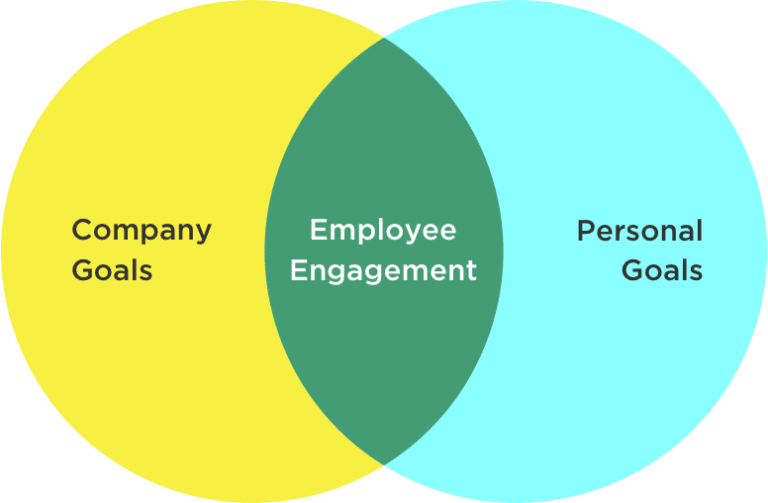
Ask each employee what their goals are and help them create actionable plans to work towards them. This means taking the time to connect with each person and understand their motivations for being there. Yes, it’s time-consuming, but if you can create a happier workforce that feels valued and respected, it’s worth it.
8. Make All Elements of Company Life Accessible
A feeling of belonging happens when your employees feel their needs are being met without having to ask. That’s why uniforms or clothing your team members are required to wear should have options for all sizes, shapes, and genders. One-size-fits-all may be the cheapest option but will likely make some feel uncomfortable.
If your team works remotely or needs certain software to do their jobs, consider making your tech stack more accessible. By choosing tools and apps that support assistive devices (like screen readers), you won’t be alienating any employees with disabilities. You may also want to allow service animals in the workplace and ensure the physical space is set up for easy maneuvering.
McKinsey believes “companies should explicitly assess belonging in internal surveys.” So, ask employees at all levels what you’re doing well and what could be improved. If you want to make it even more effective, keep it anonymous. This way, survey respondents will feel they’re able to give more detail without fear of repercussions.
How To Measure the Impact of Your DEIB Goals
According to research from Josh Bersin, “roughly 80% of companies are just going through the motions and not holding themselves accountable” for measuring the impact of their DEIB goals. HR managers seem to agree; less than 2% think they’re hitting them.
You can’t manage what you can’t measure, so you need to get specific. Here’s an example from Forbes:
“In the next year, we will increase the number of Black employees in senior leadership by 5%, invest $10 million toward initiatives focused on ending racial injustice and require all employees to attend diversity and inclusion training.”
Wondering what type of metrics you should be tracking to hit those goals? Again, it will be unique to your business, but here are some ideas to get started:
- The diversity of your applicant pool and hiring team
- Internal survey data (e.g., you could ask everyone for an Employer Net Promoter Score)
- Employee turnover
- ERG participation numbers
- The level of biased keywords and phrases on your site
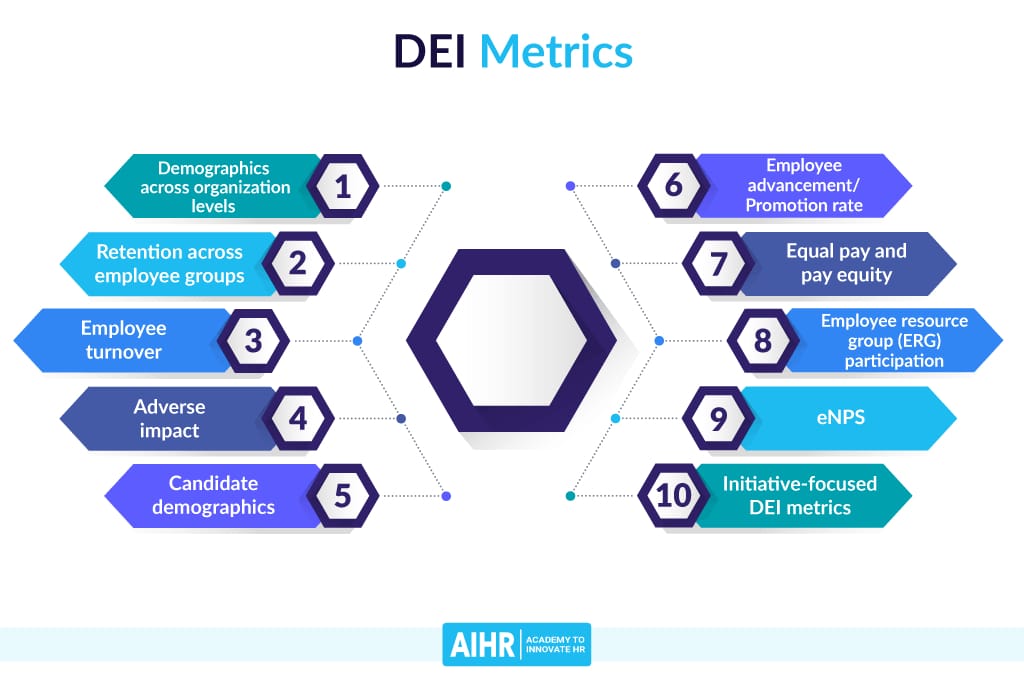
Thankfully, you don’t have to do all of this manually. There are plenty of automated employee experience (EX) tools that can get on with these processes in the background while you focus on the employee-facing part. For example:
- BetterUp – helps employees grow with your organization
- Ongig – scans text for exclusionary words
- Workhuman – eliminates unconscious bias
- Dandi – defines the metrics you want to track
Whichever method you use, the idea is to get a true overview of your company and what it’s like to work there. This may involve coming to terms with some harsh truths, but it’s important if you’re serious about fulfilling your DEIB plan.
Final Word
The beauty of implementing DEIB practices is the outcome: diversity breeds more diversity. Many find that by spending time with a more diverse group of people, they alter their initial first impressions and judgment and do so more often going forward.
Employees with a high sense of belonging are 10x more likely to be satisfied with their jobs and over twice as engaged at work. Happier employees are more productive ones. So, it’s clear that investing time and money in DEIB pays off for everyone in the long run.

Louis Carter is the founder and CEO of Best Practice Institute, Most Loved Workplace, and Results-Based Culture. Author of In Great Company, Change Champions Field Guide, and Best Practices in Talent Management, as well as a series of Leadership Development books. He is a trusted strategic advisor and coach to CEOs, CHROs, and leaders of mid-sized to F500 companies – enabling change and steering employer brand development together with highly effective teams, leaders, and organizations as a whole.

0 Comments